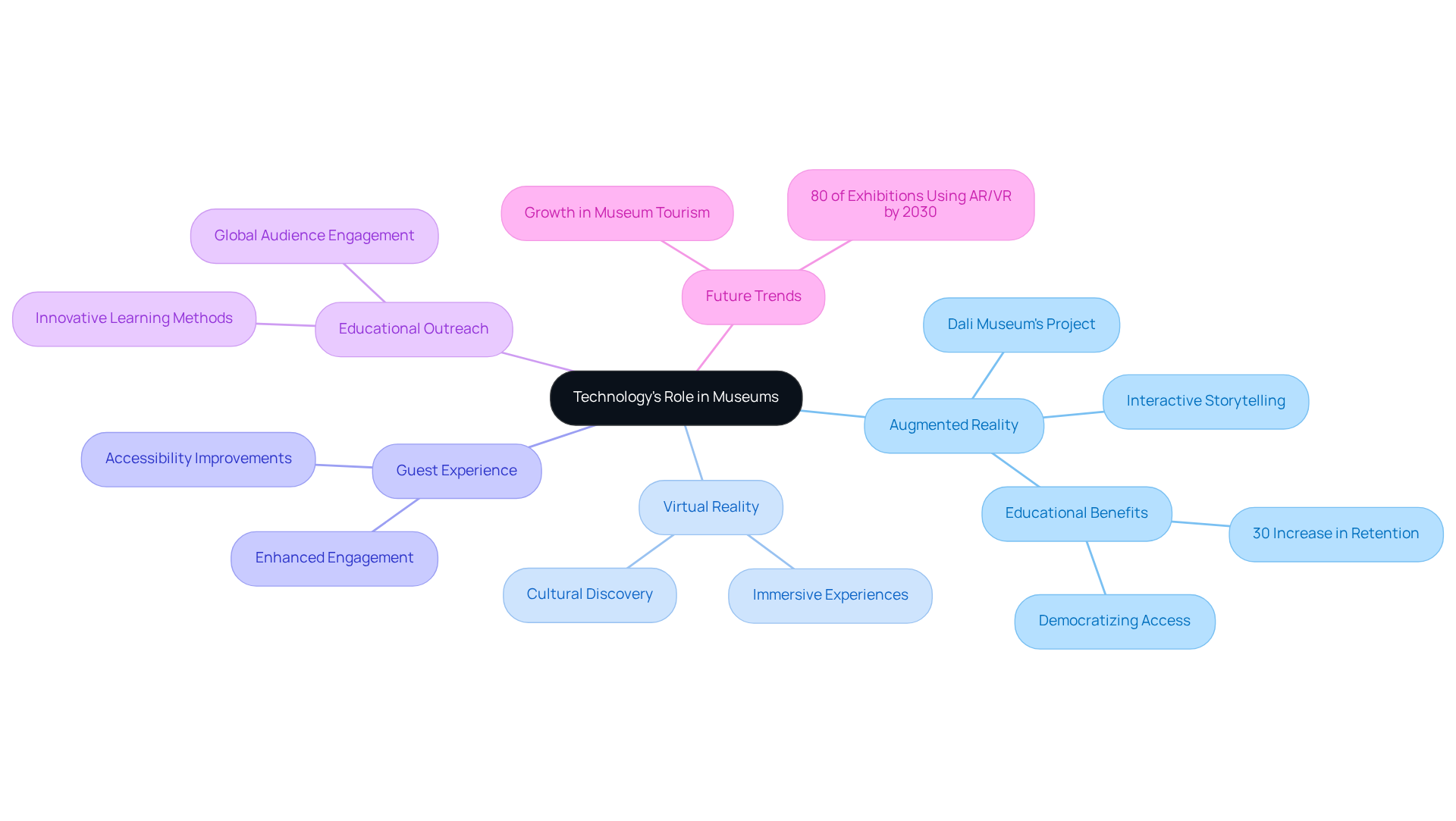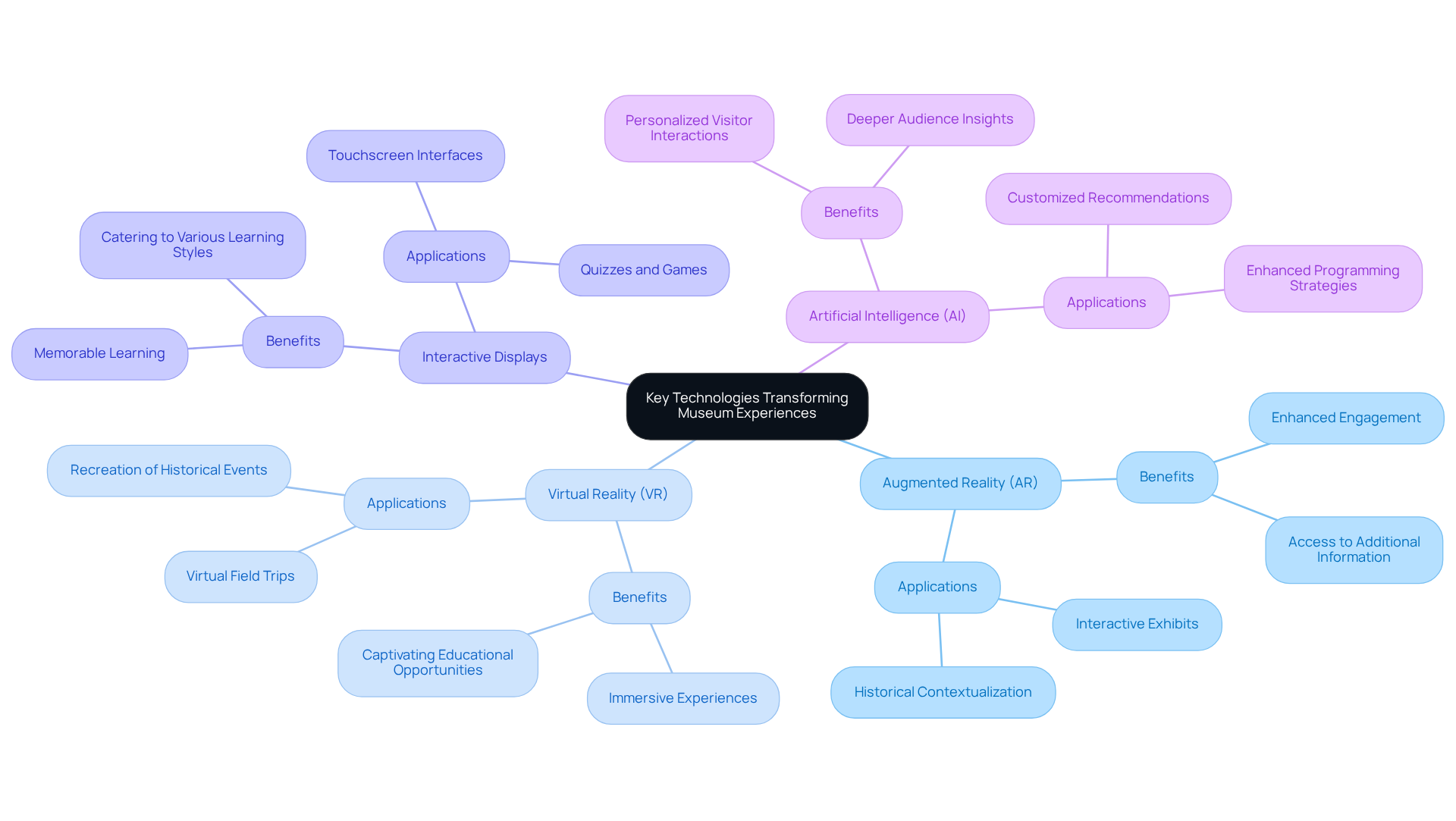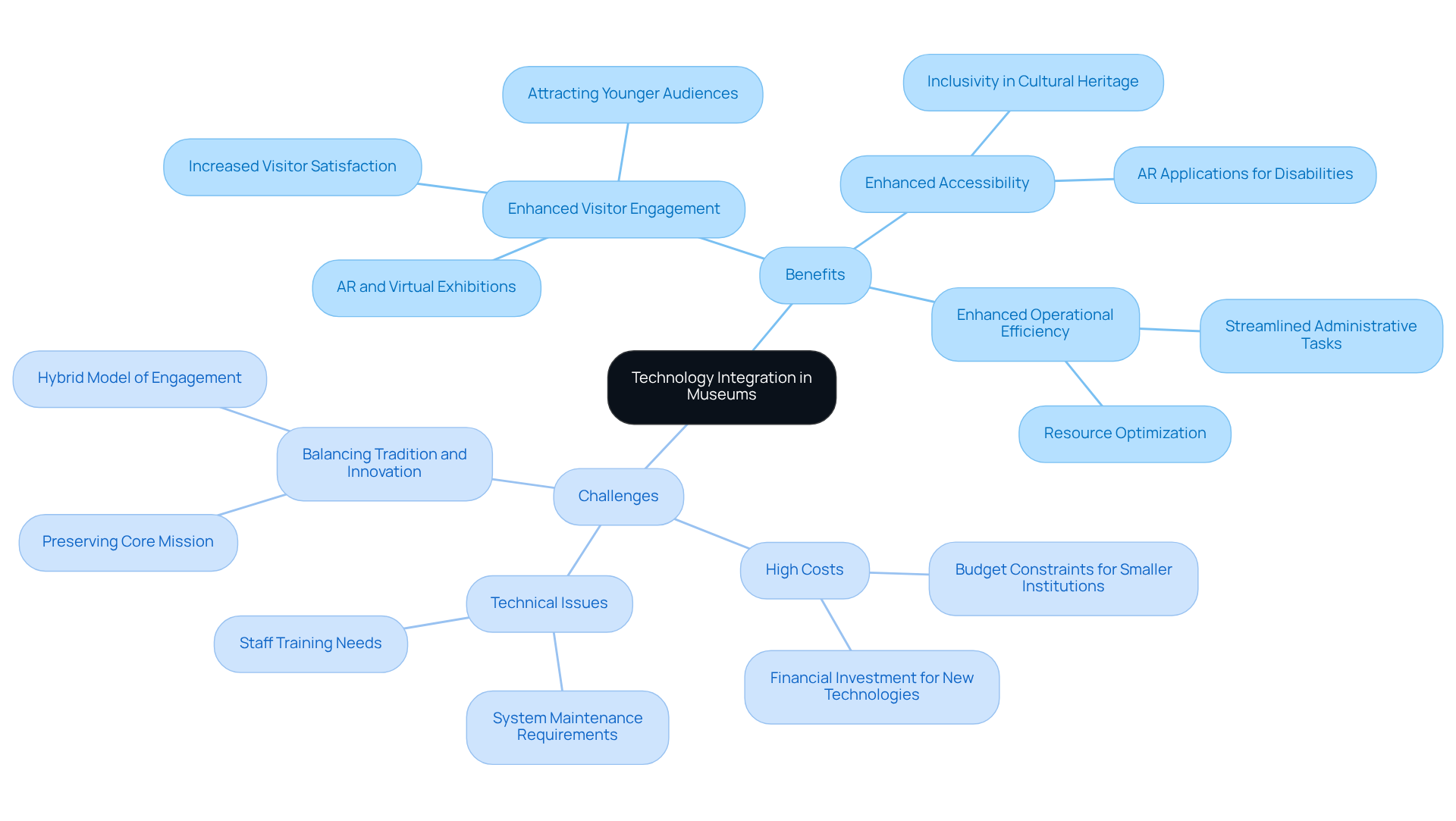Overview
This article examines the profound impact of technology on museums, underscoring how innovations such as augmented reality (AR) and virtual reality (VR) are revolutionizing visitor engagement and enhancing operational efficiency.
Historical data illustrates the evolution of technology within these institutions, demonstrating the significant benefits of improved accessibility and interactivity.
However, it is crucial to acknowledge the challenges museums encounter as they strive to balance traditional methods with contemporary advancements.
By embracing these technologies, museums can not only enhance the visitor experience but also position themselves at the forefront of cultural engagement.
Collaboration among stakeholders will be essential to navigate these complexities and fully leverage the potential of XR technologies.
Introduction
The intersection of technology and museums has ignited a revolution in audience engagement with cultural heritage, transforming static displays into dynamic, immersive experiences. As augmented reality (AR) and virtual reality (VR) reshape visitor interactions, the potential for enhanced learning and accessibility becomes increasingly evident. Research indicates that institutions integrating these innovations can significantly enrich the visitor experience.
However, as these organizations strive to embrace technological advancement, they encounter challenges that question the balance between tradition and innovation.
What does this evolving landscape mean for the future of cultural institutions? How can they harness technology to not only enrich the visitor experience but also overcome inherent obstacles?
The time for action is now; collaboration and adaptation are essential for navigating this transformative era.
Defining Technology's Role in Museums
Technology and museums encompass a diverse array of tools crafted to enhance guest experiences, optimize operational efficiency, and expand educational outreach. Among these, augmented reality (AR) and virtual reality (VR) emerge as pivotal innovations. AR significantly enhances audience engagement by integrating digital elements with real-world environments, facilitating interactive storytelling that captivates spectators. For instance, the Dali Museum's 'Dali Lives' project employs AI and AR to create a lifelike representation of Salvador Dali, enabling visitors to interact with his persona and learn about his works in an engaging manner.
The transition from traditional static displays to dynamic, interactive environments is evident in various successful AR applications across exhibition spaces. Research indicates that AR applications can yield a 30% boost in students' retention of historical information, illustrating the educational promise of these innovations. Moreover, nearly half of cultural institutions and heritage locations in Italy aimed to embrace virtual reality by 2021, signaling a rising trend towards immersive encounters.
Digital displays and AR not only enhance the storytelling aspect of exhibitions but also illustrate the role of technology and museums in democratizing access to culture and history, allowing a global audience to engage with collections remotely. Expert opinions underscore that embracing AR and VR in cultural heritage settings, as part of technology and museums, revolutionizes our interaction with history, art, and culture, fostering deeper connections with the material.
As galleries continue to evolve, the incorporation of augmented reality and virtual reality tools is anticipated to expand further. Forecasts suggest that by 2030, approximately 80% of exhibitions will employ these resources to enhance visitor interaction. This evolution signifies a profound transformation in how cultural institutions operate, shifting towards more participatory and immersive experiences that resonate with contemporary audiences.

Historical Context of Technology in Museums
The incorporation of technology and museums in cultural institutions has markedly advanced since the late 20th century, beginning with the introduction of audio guides and digital cataloging systems. These innovations laid the groundwork for enhanced guest interaction, empowering patrons to access information at their own pace. As innovation progressed, technology and museums led galleries to adopt multimedia exhibits and interactive terminals, further enriching the visitor experience. The advent of technology and museums in the 1990s marked a pivotal moment, facilitating virtual tours and online exhibitions that broadened access to collections beyond physical confines.
In recent years, technology and museums have been transformed by augmented reality (AR) and virtual reality (VR) innovations, allowing guests to engage with displays in immersive and captivating ways. Magic Playbox, an award-winning XR studio, has been at the forefront of this transformation, creating innovative AR solutions that bolster brand engagement and customer loyalty. For example, initiatives like the Japanese American Museum of San Jose's AR project strive to connect diverse communities by unveiling shared histories through interactive installations. Research indicates that the integration of AR modules can increase sales by as much as 80%, underscoring the market potential of these innovations in enhancing guest interaction. This historical trajectory underscores the ongoing evolution of cultural institutions as they adapt to technology and museums, ensuring their relevance and accessibility in a rapidly changing digital landscape.

Key Technologies Transforming Museum Experiences
The impact of technology and museums is currently transforming museum experiences, and it cannot be overstated. Augmented Reality (AR), for instance, overlays digital content onto physical artifacts, allowing visitors to access additional information and interactive elements. Galleries can utilize AR to bring historical figures to life or offer contextual insights for displays, significantly improving attendee engagement. Research indicates that more than 70% of consumers anticipate retailers to provide AR interactions, prompting museums to progressively embrace this innovation to satisfy audience demands.
Virtual Reality (VR) immerses individuals in completely new settings, enabling them to investigate historical locations or observe significant occurrences from the past. This technology proves especially effective for creating captivating educational experiences, as evidenced by institutions that have successfully integrated VR into their programming, resulting in enhanced participant satisfaction and learning outcomes.
Interactive Displays further promote participation through touchscreen interfaces and engaging exhibits, making learning more memorable. These displays can incorporate quizzes, games, and multimedia presentations that cater to various learning styles, fostering a deeper connection with the content.
Artificial Intelligence (AI) is another vital component, with AI-driven systems customizing guest interactions by offering personalized suggestions based on unique preferences and actions. This innovation not only boosts engagement but also assists cultural institutions in gaining deeper insights into their audiences, ultimately leading to more effective programming and outreach strategies.
The combination of these innovations not only enhances attendee engagement but also positions cultural institutions, including technology and museums, as creative environments that utilize advanced solutions to involve and inform their audiences. As we move forward, collaboration in adopting these technologies will be essential for maximizing their potential.

Benefits and Challenges of Technology Integration in Museums
The incorporation of technology and museums through digital tools presents a range of advantages and challenges that significantly impact guest interaction and operational effectiveness.
-
Enhanced Visitor Engagement: Interactive and immersive activities, such as augmented reality (AR) and virtual exhibitions, attract a broader audience, particularly younger generations who prefer dynamic learning environments. Research indicates that these innovations can lead to increased visitor satisfaction and engagement, encouraging return visits and favorable recommendations. Magic Playbox, a leader in AR solutions, exemplifies how such technologies can transform the exhibition experience, making it more engaging and interactive.
-
Enhanced Accessibility: Technology plays a critical role in making cultural institutions more accessible to diverse audiences, including individuals with disabilities. For instance, AR applications can offer audio descriptions for those with visual impairments, ensuring that everyone can connect with cultural heritage. Over fifty percent of cultural institutions globally are investing in digital strategies to improve accessibility and inclusivity. Magic Playbox's innovative AR solutions are pivotal in this regard, providing tools that cater to various needs and ensuring inclusivity.
-
Enhanced Operational Efficiency: Digital tools streamline various administrative tasks, such as ticketing and inventory management, allowing staff to focus on enhancing visitor experiences. This operational efficiency is essential for cultural institutions striving to optimize resources while delivering high-quality engagement. The trend towards digital interaction is evident in technology and museums, with over half of cultural institutions globally investing in these strategies. Magic Playbox's innovations facilitate this transition by providing effective solutions tailored for the cultural sector.
However, the integration of technology is accompanied by significant challenges:
-
High Costs: The financial investment required for implementing new technologies can be considerable, posing a barrier for smaller institutions. Many museums are navigating budget constraints while striving to enhance their digital offerings. Magic Playbox addresses this challenge by offering scalable solutions that accommodate various budgetary requirements, making advanced innovations more accessible.
-
Technical Issues: Ensuring that systems operate smoothly is crucial to avoid frustrating visitors. This requires ongoing maintenance and staff training to keep pace with evolving digital tools and platforms. Magic Playbox emphasizes user-friendly designs and comprehensive support to mitigate these technical challenges, ensuring a seamless integration process for museums.
-
Balancing Tradition and Innovation: Museums face the challenge of preserving traditional exhibition methods while embracing modern advancements. Striking a balance is vital to maintain their core mission of education and preservation, ensuring that innovation complements rather than overshadows foundational goals. The hybrid model of merging digital and physical experiences is essential for engaging diverse audiences, and Magic Playbox's approach illustrates this balance by enriching traditional exhibits with immersive tools.
In summary, while technology and museums provide transformative potential for enhancing visitor engagement and accessibility in cultural institutions, they also present significant challenges that require careful consideration and strategic planning. By integrating solutions from companies like Magic Playbox, museums can effectively navigate these challenges.

Conclusion
The integration of technology into museums signifies a transformative shift that enhances visitor engagement, accessibility, and operational efficiency. By embracing innovations such as augmented reality (AR), virtual reality (VR), and interactive displays, cultural institutions are redefining the visitor experience, making it more immersive and educational. This evolution captivates audiences and democratizes access to art and history, ensuring a broader demographic can appreciate and engage with cultural heritage.
Key points throughout the article highlight the historical context of technology in museums, from audio guides to sophisticated AR applications. The discussion emphasizes the benefits of these technologies, including:
- Increased visitor satisfaction
- Enhanced accessibility for diverse audiences
- Improved operational processes
However, challenges such as:
- High implementation costs
- Technical issues
- The necessity of balancing traditional exhibition methods with modern innovations
are also addressed. By navigating these complexities, museums can effectively harness technology to enrich the cultural landscape.
Ultimately, the ongoing evolution of technology in museums underscores its significance in shaping how audiences connect with art and history. As cultural institutions continue to innovate, it is crucial for them to adopt these advancements thoughtfully, ensuring they enhance rather than detract from the core mission of education and preservation. Engaging with these technologies not only enriches the visitor experience but also fosters a deeper appreciation for cultural heritage in an increasingly digital world.
Frequently Asked Questions
What is the role of technology in museums?
Technology in museums enhances guest experiences, optimizes operational efficiency, and expands educational outreach through tools like augmented reality (AR) and virtual reality (VR).
How does augmented reality (AR) enhance audience engagement in museums?
AR enhances audience engagement by integrating digital elements with real-world environments, facilitating interactive storytelling that captivates spectators.
Can you provide an example of AR used in a museum?
The Dali Museum's 'Dali Lives' project uses AI and AR to create a lifelike representation of Salvador Dali, allowing visitors to interact with his persona and learn about his works in an engaging manner.
What is the impact of AR applications on educational retention?
Research indicates that AR applications can yield a 30% boost in students' retention of historical information, showcasing their educational promise.
What trend was observed among cultural institutions in Italy regarding virtual reality by 2021?
Nearly half of cultural institutions and heritage locations in Italy aimed to embrace virtual reality by 2021, indicating a rising trend towards immersive encounters.
How do digital displays and AR contribute to access to culture and history?
Digital displays and AR democratize access to culture and history, allowing a global audience to engage with collections remotely.
What do experts say about the impact of AR and VR in cultural heritage settings?
Experts believe that embracing AR and VR in cultural heritage settings revolutionizes our interaction with history, art, and culture, fostering deeper connections with the material.
What is the anticipated future of AR and VR in museum exhibitions by 2030?
It is forecasted that by 2030, approximately 80% of exhibitions will employ AR and VR resources to enhance visitor interaction, signifying a transformation towards more participatory and immersive experiences.




